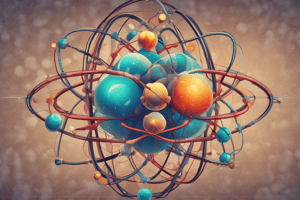Podcast
Questions and Answers
What is the branch of chemistry that studies the relationships between energy, matter, and physical processes?
What is the branch of chemistry that studies the relationships between energy, matter, and physical processes?
- Physical chemistry (correct)
- Analytical chemistry
- Organic chemistry
- Inorganic chemistry
Which concept in physical chemistry describes the maximum reversible work that can be performed by a closed system at constant temperature and pressure?
Which concept in physical chemistry describes the maximum reversible work that can be performed by a closed system at constant temperature and pressure?
- Avogadro's number
- Henry's law
- Boyle's law
- Gibbs free energy (correct)
What does entropy measure in a system during a change?
What does entropy measure in a system during a change?
- Degree of disorder or randomness (correct)
- Pressure
- Temperature
- Volume
What does the 'mole' represent in chemistry?
What does the 'mole' represent in chemistry?
In O-level moles chemistry, what is introduced to help students understand relative quantities of substances?
In O-level moles chemistry, what is introduced to help students understand relative quantities of substances?
Which branch of chemistry specifically focuses on topics like thermodynamics, kinetics, equilibrium, and statistical mechanics?
Which branch of chemistry specifically focuses on topics like thermodynamics, kinetics, equilibrium, and statistical mechanics?
What defines a mole of carbon atoms?
What defines a mole of carbon atoms?
In physical chemistry, what equation describes the Gibbs free energy change (ΔG) of a reaction?
In physical chemistry, what equation describes the Gibbs free energy change (ΔG) of a reaction?
How is the equilibrium constant (Kc) for a reaction expressed?
How is the equilibrium constant (Kc) for a reaction expressed?
What does the first law of thermodynamics state about internal energy change (ΔU)?
What does the first law of thermodynamics state about internal energy change (ΔU)?
Why are moles crucial in physical chemistry, especially in thermodynamics?
Why are moles crucial in physical chemistry, especially in thermodynamics?
How does the relationship between moles and the first law of thermodynamics typically express heat added or removed?
How does the relationship between moles and the first law of thermodynamics typically express heat added or removed?
Flashcards are hidden until you start studying
Study Notes
Exploring Chemistry: Physical Aspects and O-Level Moles
Chemistry, the science of matter and its interactions, encompasses a vast expanse of knowledge. In this exploration, we'll delve into two subfields: physical chemistry and O-level moles. Let's begin by unraveling these interconnected topics.
Physical Chemistry
Physical chemistry is a branch of chemistry that studies the relationships between energy, matter, and the physical processes that occur when changes take place within a system. This discipline focuses on topics such as thermodynamics, kinetics, equilibrium, and statistical mechanics.
One of the fundamental concepts in physical chemistry is the Gibbs free energy, which describes the maximum reversible work that can be performed by a closed system at constant temperature and pressure. Another key concept is entropy, which measures the degree of disorder or randomness in a system during a change.
O-Level Moles
In the context of chemistry, the term "mole" refers to a unit of measurement used to compare the quantities of different substances. The O-level moles specifically refer to the study of moles at the level of secondary education, often in the context of the General Certificate of Secondary Education (GCSE, or O-level in some countries) examinations.
In the O-level syllabus, moles are introduced to help students understand the concept of relative quantities of substances. For instance, a mole of carbon atoms is defined as the amount of carbon that contains 6.022 x 10^23 atoms, a number known as Avogadro's number. This concept greatly simplifies the way chemists measure the quantity of substances, as it allows them to compare the masses of substances using their molar masses.
Moles in Physical Chemistry
The concept of moles is crucial in physical chemistry as well, particularly in thermodynamics, where the relationship between the amount of substance and energy changes is essential for understanding processes like chemical reactions, phase transitions, and chemical equilibrium.
For example, the Gibbs free energy change (ΔG) of a reaction is described by the equation:
ΔG = Σ(nxi * ΔGf_i)
where n_i is the number of moles of species i involved in the reaction, and ΔGf_i is the standard Gibbs free energy change for the formation of species i.
Another example is the relationship between moles and the first law of thermodynamics, which states that the change in internal energy of a system (ΔU) is equal to the heat added or removed (q) minus the work done (w) on the system. In this equation, the heat added or removed is typically expressed in terms of moles, as heat capacity is often defined for moles of a substance.
Moles and Chemical Equilibrium
The concept of moles is also essential in understanding chemical equilibrium, as it helps to determine the relative amounts of reactants and products in a reaction. The equilibrium constant (Kc) for a reaction is given by the expression:
Kc = [products]^n / [reactants]^m
where [products] and [reactants] are the concentrations of the products and reactants, and n and m are the stoichiometric coefficients of the products and reactants, respectively. When the equilibrium constant is expressed in terms of moles, it provides a convenient and easy-to-use tool for calculating equilibrium concentrations and determining the direction of a reaction.
Conclusion
Physical chemistry and O-level moles are interconnected and interdependent concepts in the field of chemistry. Understanding these ideas provides a strong foundation for students and professionals alike to delve deeper into the vast world of chemistry. As you continue your journey in chemistry, remember that mastering the concepts of physical chemistry and moles will open doors to further understanding the intricacies of matter and its interactions.
Studying That Suits You
Use AI to generate personalized quizzes and flashcards to suit your learning preferences.




